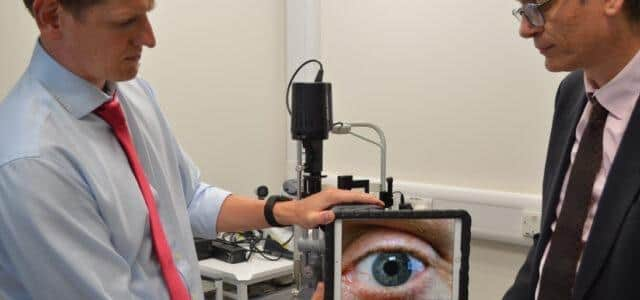NHS Forth Valley says pioneering device could soon be detecting patients' eye diseases
and live on Freeview channel 276
Developed by researchers from the University of Strathclyde, the device captures 3-D images of the retina, the back of the eye and cornea, and can be added at low cost to a slit lamp, a device commonly used by optometrists.
Patients with conditions such as glaucoma, the third most common cause of visual impairment worldwide, with an estimated 7.7 million people affected, are often
Advertisement
Hide AdAdvertisement
Hide Addiagnosed by highly-trained specialists, who look at photos and give a subjective opinion on the 3D structure of the back of the eye.


Although there are existing instruments for 3D imaging, including Optical Coherence Tomography technology – those machines can cost up to £100,000, often making
them too expensive for large-scale population use, especially in low-income countries.
However, optometrists all over the world have access to slit lamps. The new technology is a simple and inexpensive add-on to a standard lamp, and can extend 3D eye imaging to all settings where optometrists are present.
Advertisement
Hide AdAdvertisement
Hide AdIt is so simple that a modified version of the technology brings potential of 3D retinal “selfies" without an operator, meaning it could also be deployed in unassisted settings, like pharmacies.
The device has been developed by Dr Mario Giardini, Dr Ian Coghill, and Kirsty Jordan, at the Department of Biomedical Engineering of the University of Strathclyde.
Dr Iain Livingstone, Consultant Ophthalmologist at NHS Forth Valley, has collaborated with Dr Giardini on previous ophthalmology projects.
He said: “So much of what we do as eye doctors depends on seeing things in 3D. While photographs can be helpful, this innovation uses visible light to re-create a high fidelity 3D representation of eye structures, allowing precise measurements to be taken in a completely new way, piggybacking on the method of examination we already do routinely.
Advertisement
Hide AdAdvertisement
Hide Ad“It’s a crucial addition to the way we interpret information, harnessing digital to glean so much more from a slit lamp exam, with potential reach far beyond the hospital toward Community Optometry, bringing nuanced measuring tools closer to home for patients.
“This addition also turns a slit lamp into a ‘3D eye scanner’ with potential to supplant ocular ultrasound for measuring solid tumours of the eye.”
Comment Guidelines
National World encourages reader discussion on our stories. User feedback, insights and back-and-forth exchanges add a rich layer of context to reporting. Please review our Community Guidelines before commenting.
